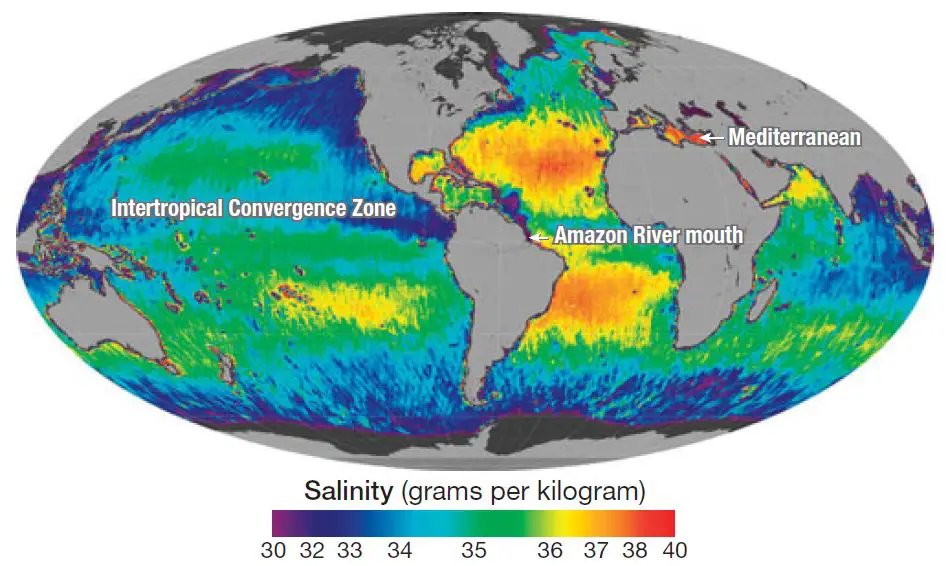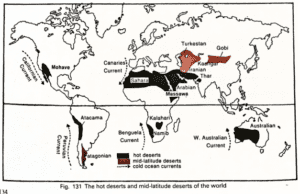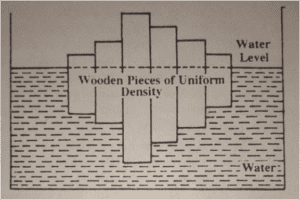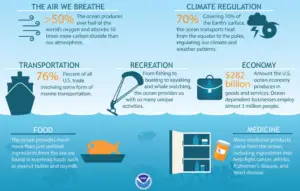Table of Contents
[ Image explanation – Lowest salinity (violet and blue areas) is found in areas of freshwater runoff, such as the mouths of rivers, and where rainfall is high (as in the ITCZ); highest salinity (red and yellow) is found where evaporation rates are highest.]
Factors affecting the salinity of the sea or ocean water | UPSC – IAS
The salinity of ocean water is a measure of the concentration of dissolved salts, which are mostly – sodium chloride but also include salts containing magnesium, sulfur, calcium, and potassium. The average salinity of seawater is about 35 parts per thousand, or 3.5 percent of total mass.
- The geographic distribution of surface salinity varies. At any given location on the ocean surface, the salinity depends on how much evaporation is taking place and how much freshwater (primarily from rainfall and stream discharge) is being added.
What are the two factors that affect the salinity of ocean water ?
- The salinity of Ocean water in the surface layer of oceans depend mainly on evaporation and precipitation.
- Evaporation of ocean water and formation of sea ice both increase the salinity of the ocean.
- However these “salinity raising” factors are continually counter-balanced by the processes that decrease salinity such as the continuous input of fresh water from, precipitation of – rain, rivers & snow.
Note – Where the evaporation rate is high, so is salinity; where the inflow of freshwater is high, salinity is low
- Surface salinity is greatly influenced in coastal regions by the freshwater flow from rivers, and in polar regions by the processes of freezing and thawing of ice.
- Wind, also influences salinity of an area by transferring water to other areas.
- The ocean currents contribute to the salinity variations. Salinity, temperature and density of water are interrelated. Hence, any change in the temperature or density influences the salinity of an area.
Highest and Lowest Salinity of Ocean Water | UPSC – IAS
Typically the lowest salinities are found where rainfall is heavy and near the mouths of major rivers. Salinity is highest in partly landlocked seas in dry, hot regions because here the evaporation rate is high and stream discharge is minimal.
As a general pattern, salinity is low in equatorial regions because of heavy rainfall, cloudiness, and humidity, all of which inhibit evaporation, and also because of considerable river discharge. Salinity rises to a general maximum in the subtropics, where precipitation is low and evaporation extensive, and decreases to a general minimum in the polar regions, where evaporation is minimal and there is considerable inflow of freshwater from rivers and ice caps. Where the evaporation rate is high, so is salinity; where the inflow of freshwater is high, salinity is low
Note – Atlantic ocean is saltiest out of all oceans
- Surface waters in the Atlantic have the highest salinity, higher than 37 parts per thousand in some areas. This is because, on average, there is more evaporation than combined rainfall and river runoff into the Atlantic Ocean, maintaining higher salinity than in the other basins.
- Effects of ocean salinity – Although ocean salinity does vary from place to place, the variability of dissolved salt is very small: from about 32 parts per thousand to about 37 parts per thousand. Nonetheless, this small variation can have a massive influence on ocean circulation.
Salinity of Ocean water Affects Ocean Water Density | UPSC – IAS
- Seawater density varies with temperature, degree of salinity, and depth. High temperature produces low density, and high salinity produces high density. Deep water has high density because of low temperature and because of the pressure of the overlying water.
- Surface layers of seawater tend to contract and sink in cold regions, whereas in warmer areas deeper waters tend to rise to the surface.
- Surface currents also affect this situation, particularly by producing an upwelling of colder, denser water in some localities. As we will see later in this chapter, differences in density are partially responsible for a vast, slow circulation of deep ocean water.
Salinity of freshwater | UPSC – IAS
- Salinity of freshwater is nearly equal to zero. The salinity of water in the ocean averages about 35 parts per thousand (ppt). The mixture of seawater and fresh water in estuaries is called brackish water and its salinity can range from 0.5 to 35 ppt.
Vertical distribution of salinity in oceans | UPSC – IAS
- Very cold and very salty water forms in polar regions every winter. This cold and salty water is denser, so it sinks toward the seafloor.
Pacific ocean salinity
Salinity also varies latitudinally, reaching a maximum of 37 parts per thousand in the southeastern area. The water near the equator, which can have a salinity as low as 34 parts per thousand, is less salty than that found in the mid-latitudes because of abundant equatorial precipitation throughout the year.
- Indian ocean salinity – The surface salinity in Indian ocean ranges from 32 to 37 parts per 1000.
Enclosed Seas in the world (example)
- Enclosed Sea — black sea ,dead sea
- Partially enclosed Sea – Mediterranean sea, red sea




